Initial and Diagnostic Assessment: Agreeing on Learning Goals
VerifiedAdded on 2023/06/17
|5
|729
|124
Report
AI Summary
This assignment focuses on the use of initial and diagnostic assessments in education to identify and meet individual learning needs. It highlights the importance of understanding learners' strengths and weaknesses to develop their talents and create interest in learning. The report discusses the roles of initial assessment in determining a learner's starting point and aligning learning programs with their abilities, and diagnostic assessment in identifying specific skill-area needs for targeted support. It emphasizes the significance of these assessments in planning differentiated activities and adjusting teaching criteria to ensure effective learning outcomes, with references to relevant books and journals.
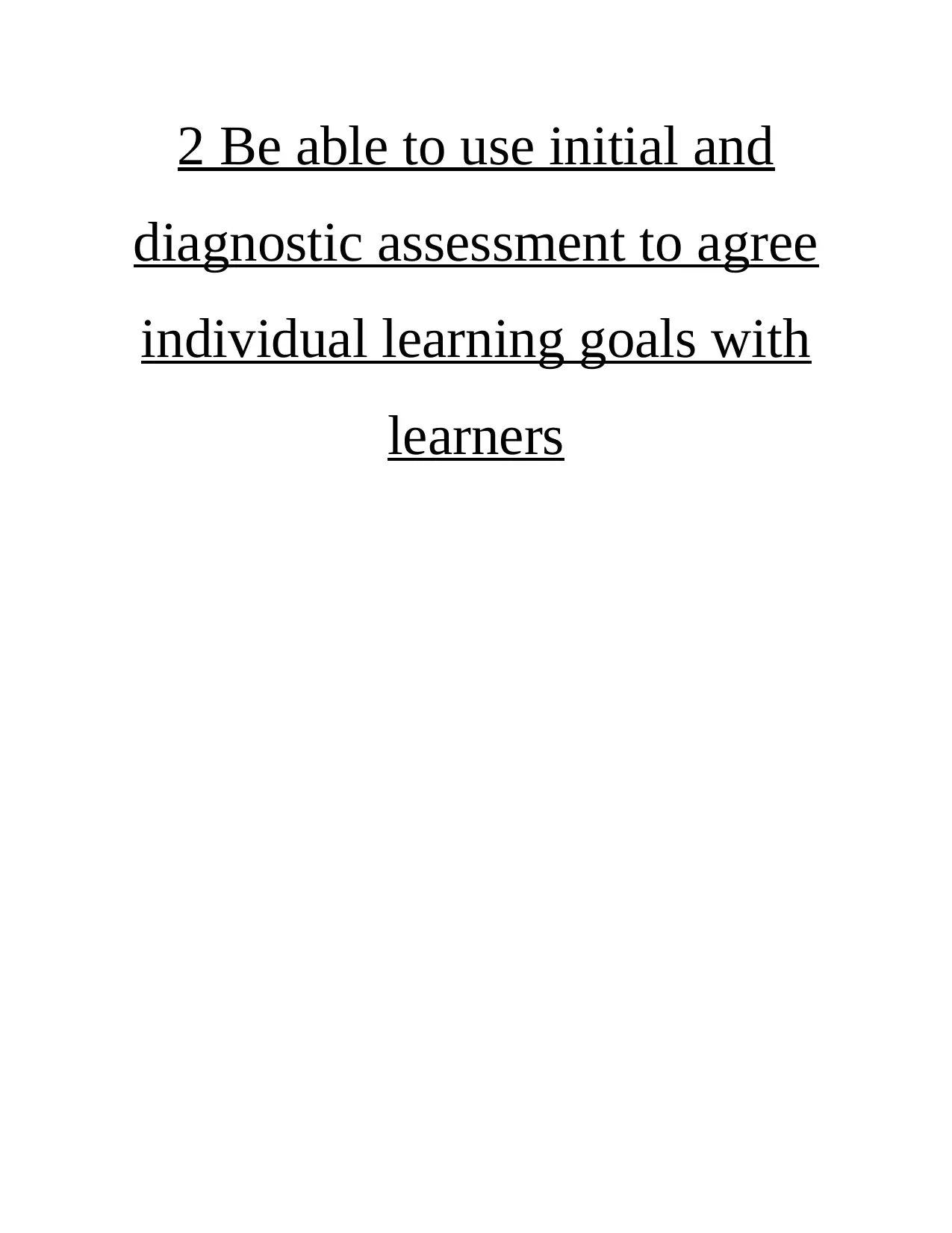
2 Be able to use initial and
diagnostic assessment to agree
individual learning goals with
learners
diagnostic assessment to agree
individual learning goals with
learners
Paraphrase This Document
Need a fresh take? Get an instant paraphrase of this document with our AI Paraphraser
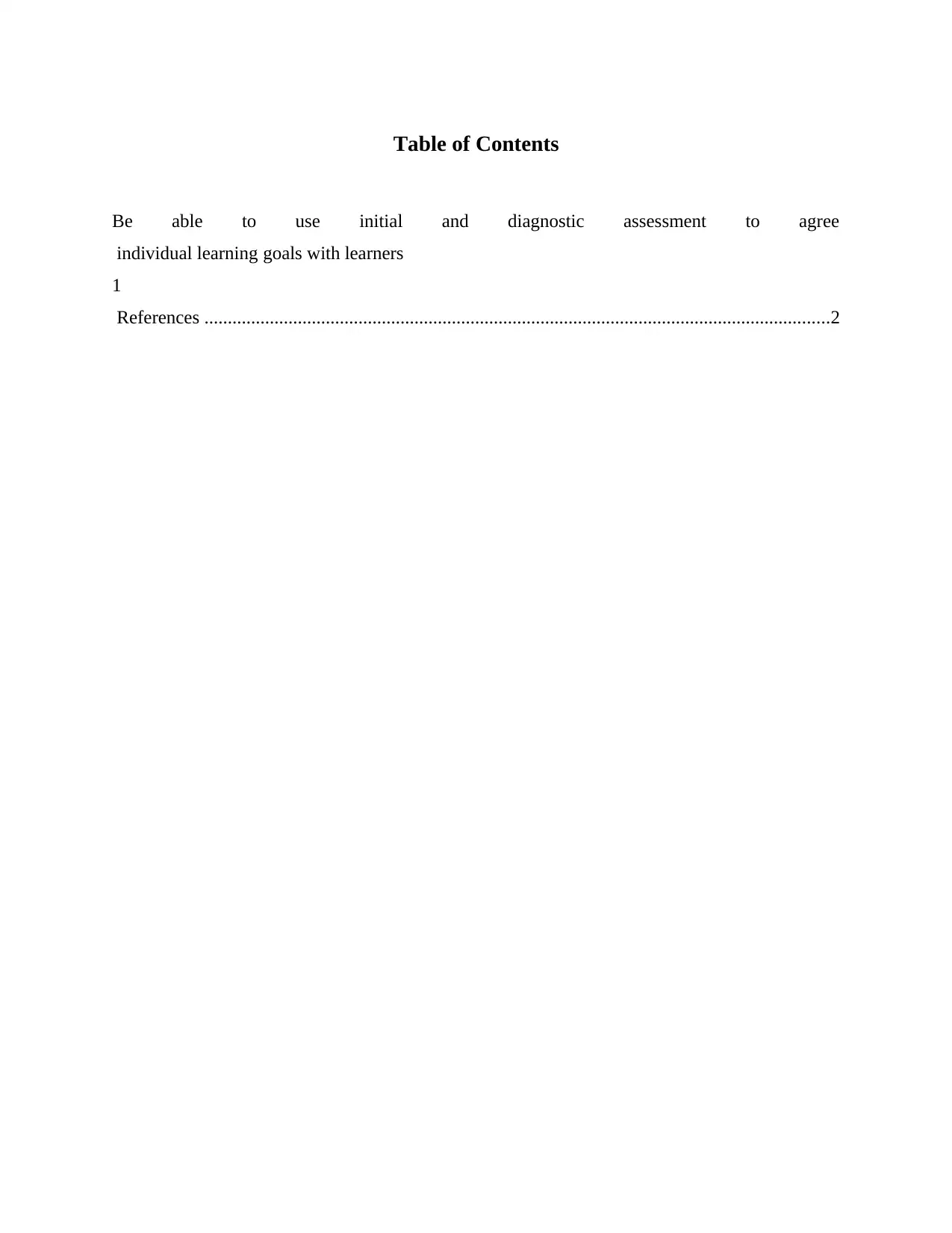
Table of Contents
Be able to use initial and diagnostic assessment to agree
individual learning goals with learners
1
References ......................................................................................................................................2
Be able to use initial and diagnostic assessment to agree
individual learning goals with learners
1
References ......................................................................................................................................2
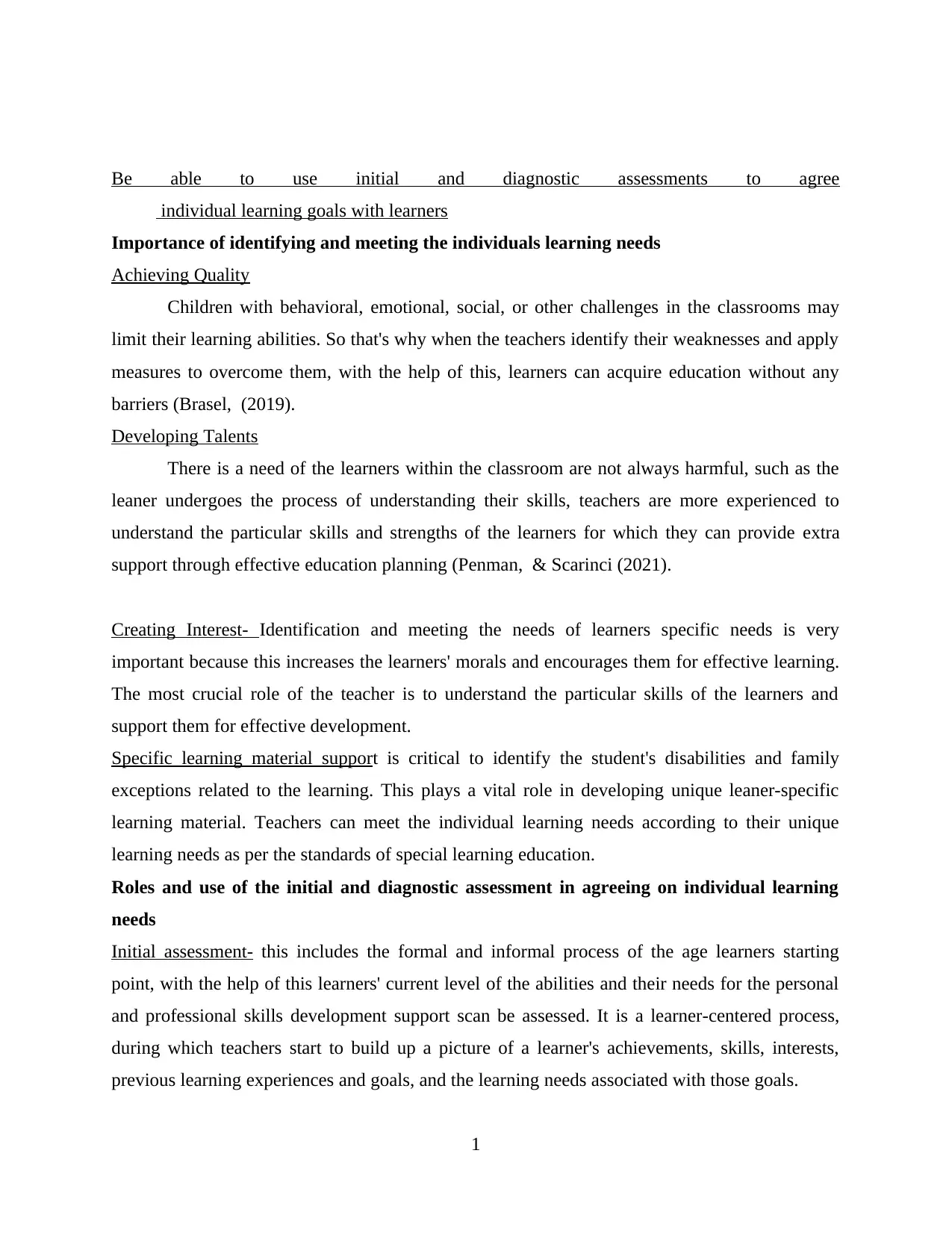
Be able to use initial and diagnostic assessments to agree
individual learning goals with learners
Importance of identifying and meeting the individuals learning needs
Achieving Quality
Children with behavioral, emotional, social, or other challenges in the classrooms may
limit their learning abilities. So that's why when the teachers identify their weaknesses and apply
measures to overcome them, with the help of this, learners can acquire education without any
barriers (Brasel, (2019).
Developing Talents
There is a need of the learners within the classroom are not always harmful, such as the
leaner undergoes the process of understanding their skills, teachers are more experienced to
understand the particular skills and strengths of the learners for which they can provide extra
support through effective education planning (Penman, & Scarinci (2021).
Creating Interest- Identification and meeting the needs of learners specific needs is very
important because this increases the learners' morals and encourages them for effective learning.
The most crucial role of the teacher is to understand the particular skills of the learners and
support them for effective development.
Specific learning material support is critical to identify the student's disabilities and family
exceptions related to the learning. This plays a vital role in developing unique leaner-specific
learning material. Teachers can meet the individual learning needs according to their unique
learning needs as per the standards of special learning education.
Roles and use of the initial and diagnostic assessment in agreeing on individual learning
needs
Initial assessment- this includes the formal and informal process of the age learners starting
point, with the help of this learners' current level of the abilities and their needs for the personal
and professional skills development support scan be assessed. It is a learner-centered process,
during which teachers start to build up a picture of a learner's achievements, skills, interests,
previous learning experiences and goals, and the learning needs associated with those goals.
1
individual learning goals with learners
Importance of identifying and meeting the individuals learning needs
Achieving Quality
Children with behavioral, emotional, social, or other challenges in the classrooms may
limit their learning abilities. So that's why when the teachers identify their weaknesses and apply
measures to overcome them, with the help of this, learners can acquire education without any
barriers (Brasel, (2019).
Developing Talents
There is a need of the learners within the classroom are not always harmful, such as the
leaner undergoes the process of understanding their skills, teachers are more experienced to
understand the particular skills and strengths of the learners for which they can provide extra
support through effective education planning (Penman, & Scarinci (2021).
Creating Interest- Identification and meeting the needs of learners specific needs is very
important because this increases the learners' morals and encourages them for effective learning.
The most crucial role of the teacher is to understand the particular skills of the learners and
support them for effective development.
Specific learning material support is critical to identify the student's disabilities and family
exceptions related to the learning. This plays a vital role in developing unique leaner-specific
learning material. Teachers can meet the individual learning needs according to their unique
learning needs as per the standards of special learning education.
Roles and use of the initial and diagnostic assessment in agreeing on individual learning
needs
Initial assessment- this includes the formal and informal process of the age learners starting
point, with the help of this learners' current level of the abilities and their needs for the personal
and professional skills development support scan be assessed. It is a learner-centered process,
during which teachers start to build up a picture of a learner's achievements, skills, interests,
previous learning experiences and goals, and the learning needs associated with those goals.
1
⊘ This is a preview!⊘
Do you want full access?
Subscribe today to unlock all pages.

Trusted by 1+ million students worldwide
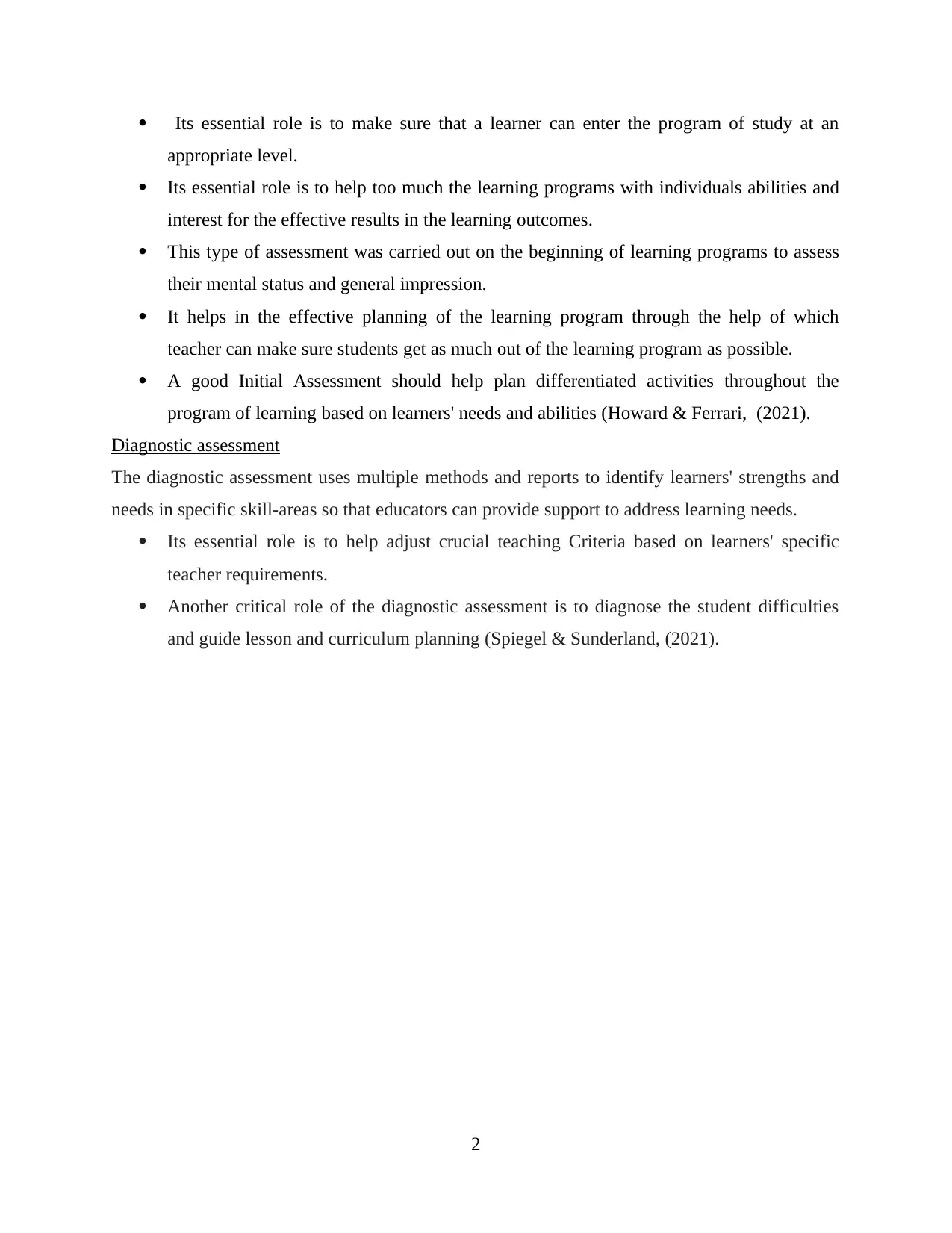
Its essential role is to make sure that a learner can enter the program of study at an
appropriate level.
Its essential role is to help too much the learning programs with individuals abilities and
interest for the effective results in the learning outcomes.
This type of assessment was carried out on the beginning of learning programs to assess
their mental status and general impression.
It helps in the effective planning of the learning program through the help of which
teacher can make sure students get as much out of the learning program as possible.
A good Initial Assessment should help plan differentiated activities throughout the
program of learning based on learners' needs and abilities (Howard & Ferrari, (2021).
Diagnostic assessment
The diagnostic assessment uses multiple methods and reports to identify learners' strengths and
needs in specific skill-areas so that educators can provide support to address learning needs.
Its essential role is to help adjust crucial teaching Criteria based on learners' specific
teacher requirements.
Another critical role of the diagnostic assessment is to diagnose the student difficulties
and guide lesson and curriculum planning (Spiegel & Sunderland, (2021).
2
appropriate level.
Its essential role is to help too much the learning programs with individuals abilities and
interest for the effective results in the learning outcomes.
This type of assessment was carried out on the beginning of learning programs to assess
their mental status and general impression.
It helps in the effective planning of the learning program through the help of which
teacher can make sure students get as much out of the learning program as possible.
A good Initial Assessment should help plan differentiated activities throughout the
program of learning based on learners' needs and abilities (Howard & Ferrari, (2021).
Diagnostic assessment
The diagnostic assessment uses multiple methods and reports to identify learners' strengths and
needs in specific skill-areas so that educators can provide support to address learning needs.
Its essential role is to help adjust crucial teaching Criteria based on learners' specific
teacher requirements.
Another critical role of the diagnostic assessment is to diagnose the student difficulties
and guide lesson and curriculum planning (Spiegel & Sunderland, (2021).
2
Paraphrase This Document
Need a fresh take? Get an instant paraphrase of this document with our AI Paraphraser
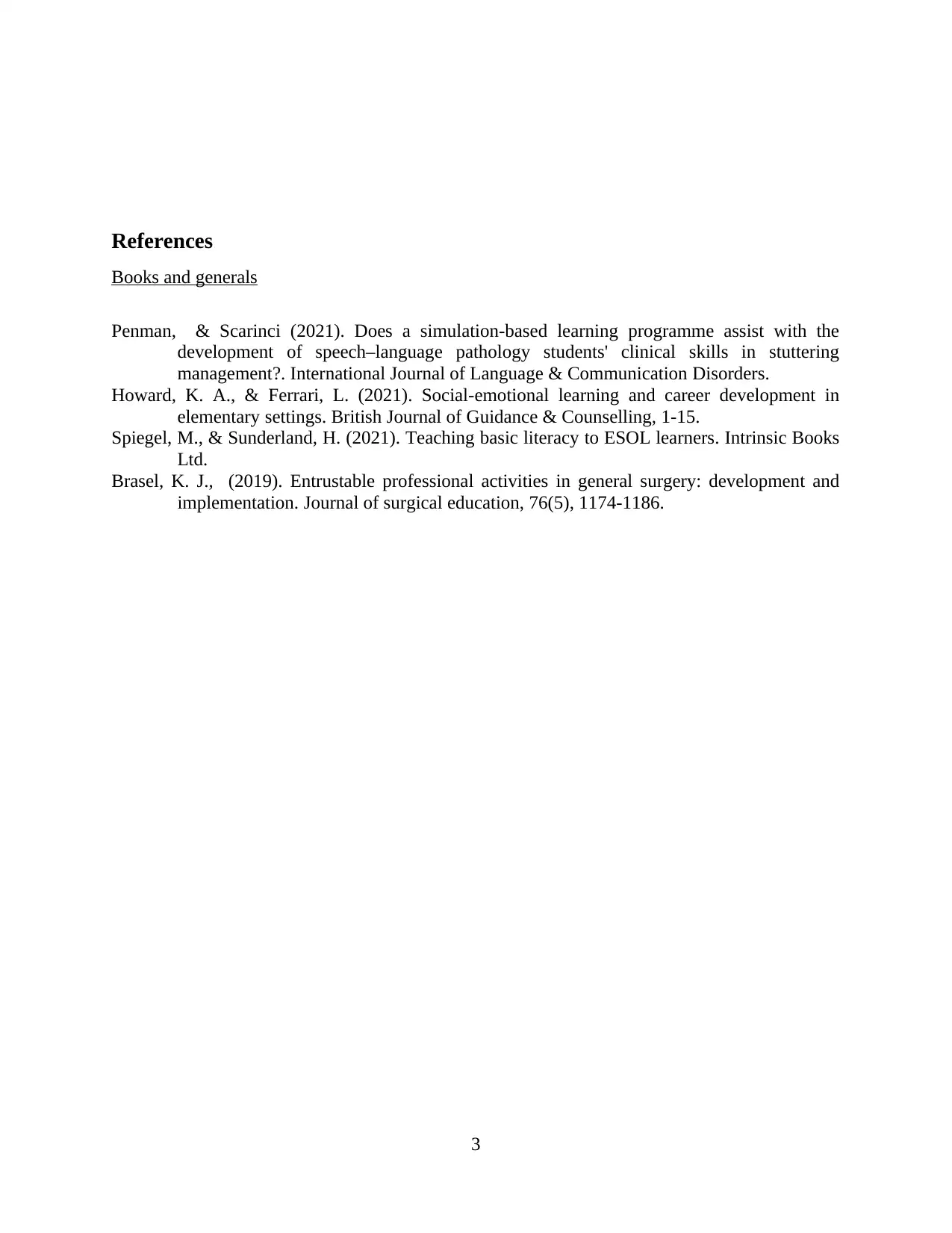
References
Books and generals
Penman, & Scarinci (2021). Does a simulation‐based learning programme assist with the
development of speech–language pathology students' clinical skills in stuttering
management?. International Journal of Language & Communication Disorders.
Howard, K. A., & Ferrari, L. (2021). Social-emotional learning and career development in
elementary settings. British Journal of Guidance & Counselling, 1-15.
Spiegel, M., & Sunderland, H. (2021). Teaching basic literacy to ESOL learners. Intrinsic Books
Ltd.
Brasel, K. J., (2019). Entrustable professional activities in general surgery: development and
implementation. Journal of surgical education, 76(5), 1174-1186.
3
Books and generals
Penman, & Scarinci (2021). Does a simulation‐based learning programme assist with the
development of speech–language pathology students' clinical skills in stuttering
management?. International Journal of Language & Communication Disorders.
Howard, K. A., & Ferrari, L. (2021). Social-emotional learning and career development in
elementary settings. British Journal of Guidance & Counselling, 1-15.
Spiegel, M., & Sunderland, H. (2021). Teaching basic literacy to ESOL learners. Intrinsic Books
Ltd.
Brasel, K. J., (2019). Entrustable professional activities in general surgery: development and
implementation. Journal of surgical education, 76(5), 1174-1186.
3
1 out of 5
Related Documents
Your All-in-One AI-Powered Toolkit for Academic Success.
+13062052269
info@desklib.com
Available 24*7 on WhatsApp / Email
![[object Object]](/_next/static/media/star-bottom.7253800d.svg)
Unlock your academic potential
Copyright © 2020–2025 A2Z Services. All Rights Reserved. Developed and managed by ZUCOL.





